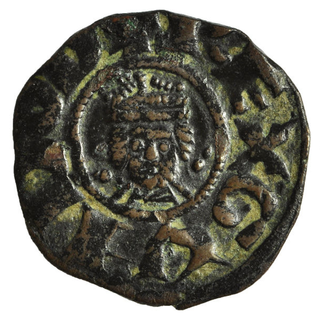
Guy of Lusignan was a French Poitevin knight, son of Hugh VIII of Lusignan and as such born of the House of Lusignan. He was king of Jerusalem from 1186 to 1192 by right of marriage to Sibylla of Jerusalem, and King of Cyprus from 1192 to 1194. Having arrived in the Holy Land at an unknown date, Guy was hastily married to Sibylla in 1180 to prevent a political incident within the kingdom. As the health of his brother-in-law, Baldwin IV of Jerusalem, deteriorated, Guy was appointed by Sibylla as regent for his stepson, Baldwin V of Jerusalem. Baldwin IV died in 1185, followed shortly by Baldwin V in 1186, leading to the succession of Sibylla and Guy to the throne. Guy's reign was marked by increased hostilities with the Ayyubids ruled by Saladin, culminating in the Battle of Hattin in July 1187—during which Guy was captured—and the fall of Jerusalem itself three months later.

Isabella I was reigning Queen of Jerusalem from 1190 to her death in 1205. She was the daughter of Amalric I of Jerusalem and his second wife Maria Comnena, a Byzantine princess. Her half-brother, Baldwin IV of Jerusalem, engaged her to Humphrey IV of Toron. Her mother's second husband, Balian of Ibelin, and his stepfather, Raynald of Châtillon, were influential members of the two baronial parties. The marriage of Isabella and Humphrey was celebrated in Kerak Castle in autumn 1183. Saladin, the Ayyubid sultan of Egypt and Syria, laid siege to the fortress during the wedding, but Baldwin IV forced him to lift the siege.
Hugh III, also called Hugh of Antioch-Lusignan and the Great, was the king of Cyprus from 1267 and king of Jerusalem from 1268. Born into the family of the princes of Antioch, he effectively ruled as regent for underage kings Hugh II of Cyprus and Conrad III of Jerusalem for several years. Prevailing over the claims of his cousin Hugh of Brienne, he succeeded both young monarchs upon their deaths and appeared poised to be an effective political and military leader.
Joscelin III of Edessa was the titular Count of Edessa, who during his lifetime managed to amass enough land to establish the Seigneurie of Joscelin.
Ruben III, also Roupen III, Rupen III, or Reuben III, was the ninth lord of Armenian Cilicia (1175–1187).
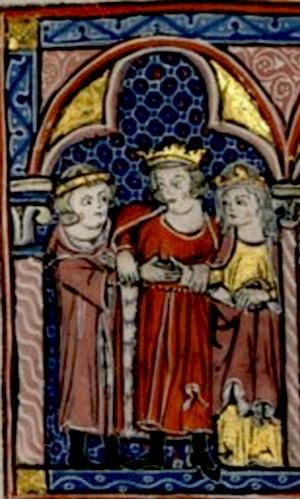
Humphrey IV of Toron was a leading baron in the Kingdom of Jerusalem. He inherited the Lordship of Toron from his grandfather, Humphrey II, in 1179. He was also heir to the Lordship of Oultrejourdan through his mother, Stephanie of Milly. In 1180, he renounced Toron on his engagement to Isabella, the half-sister of Baldwin IV of Jerusalem. The king, who had suffered from leprosy, allegedly wanted to prevent Humphrey from uniting two large fiefs. Humphrey married Isabella in Kerak Castle in autumn 1183. Saladin, the Ayyubbid sultan of Egypt and Syria, laid siege to Kerak during the wedding, but Baldwin IV and Raymond III of Tripoli relieved the fortress.

The Crusader state of the Kingdom of Jerusalem, created in 1099, was divided into a number of smaller seigneuries. According to the 13th-century jurist John of Ibelin, the four highest crown vassals in the kingdom proper were the count of Jaffa and Ascalon, the prince of Galilee, the lord of Sidon, and the lord of Oultrejordain.
Humphrey II of Toron was lord of Toron and constable of the Kingdom of Jerusalem. He was the son of Humphrey I of Toron.
Stephanie of Milly was the lady of Oultrejordain in 1169–1197 and an influential figure in the Kingdom of Jerusalem. She was also known as Stephanie de Milly, Etienette de Milly, and Etiennette de Milly. She married three times; firstly to Humphrey III of Toron, secondly to Miles of Plancy; her third and last husband was Raynald of Chatillon.
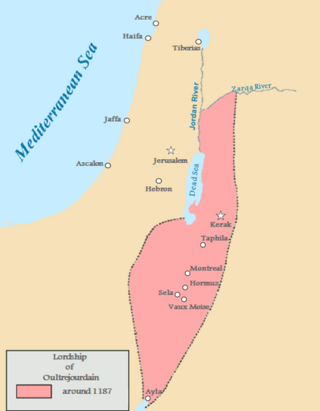
The Lordship of Oultrejordain or Oultrejourdain was the name used during the Crusades for an extensive and partly undefined region to the east of the Jordan River, an area known in ancient times as Edom and Moab. It was also referred to as Transjordan.
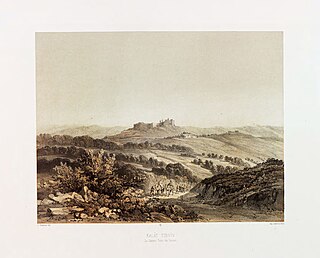
Toron, now Tibnin or Tebnine in southern Lebanon, was a major Crusader castle, built in the Lebanon mountains on the road from Tyre to Damascus. The castle was the centre of the Lordship of Toron, a seigneury within the Kingdom of Jerusalem, actually a rear-vassalage of the Principality of Galilee.
Baldwin of Ibelin, also known as Baldwin II of Ramla, was an important noble of the Kingdom of Jerusalem in the 12th century and was lord of Ramla from 1169-1186. He was the second son of Barisan of Ibelin, and was the younger brother of Hugh of Ibelin and older brother of Balian of Ibelin. He first appears in the historical record as a witness to charters in 1148.
Miles of Plancy, also known as Milon or Milo, was a noble in the crusader Kingdom of Jerusalem.

The principality of Galilee was one of the four major seigneuries of the crusader Kingdom of Jerusalem, according to 13th-century commentator John of Ibelin, grandson of Balian. The direct holdings of the principality centred around Tiberias, in Galilee proper, but with all its vassals, the lordship covered all Galilee and southern Phoenicia. The independent Lordship of Sidon was located between Galilee's holdings. The principality also had its own vassals: the Lordships of Beirut, Nazareth, and Haifa.

Maria Komnene, Latinized Comnena, was the queen of Jerusalem from 1167 until 1174 as the second wife of King Amalric. She occupied a central position in the Kingdom of Jerusalem for twenty years, earning a reputation for intrigue and ruthlessness.
Philippa of Armenia was an Empress of Nicaea. She was a daughter of Ruben III of Armenia and Isabella of Toron. Her maternal grandparents were Humphrey III of Toron and Stephanie of Milly.
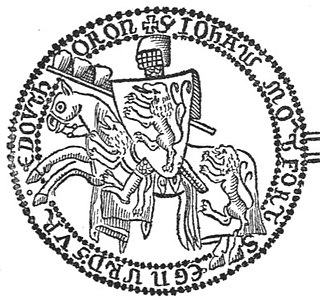
John of Montfort was lord of Toron from 1257 to 1266 and Lord of Tyre from 1270 to 1283. He was the son of Philip of Montfort, and his second wife Maria of Antioch-Armenia.
Humphrey of Montfort was a nobleman of the Kingdom of Jerusalem.
Alice of Armenia was ruling Lady of Toron from 1229 to 1234 as the eldest daughter of Ruben III, Prince of Armenia and his wife Isabella of Toron. She was heiress of Toron as well as a claimant to the throne of Armenia. She married three times; by her second marriage she was Countess of Tripoli, and she only had children from this marriage.
Isabella of Toron also known as Isabelle or Zabel was the daughter of Humphrey III, Lord of Toron and his wife Stephanie of Milly. Isabella was titular lady of Toron in her own right and was princess of Armenia by her marriage.








